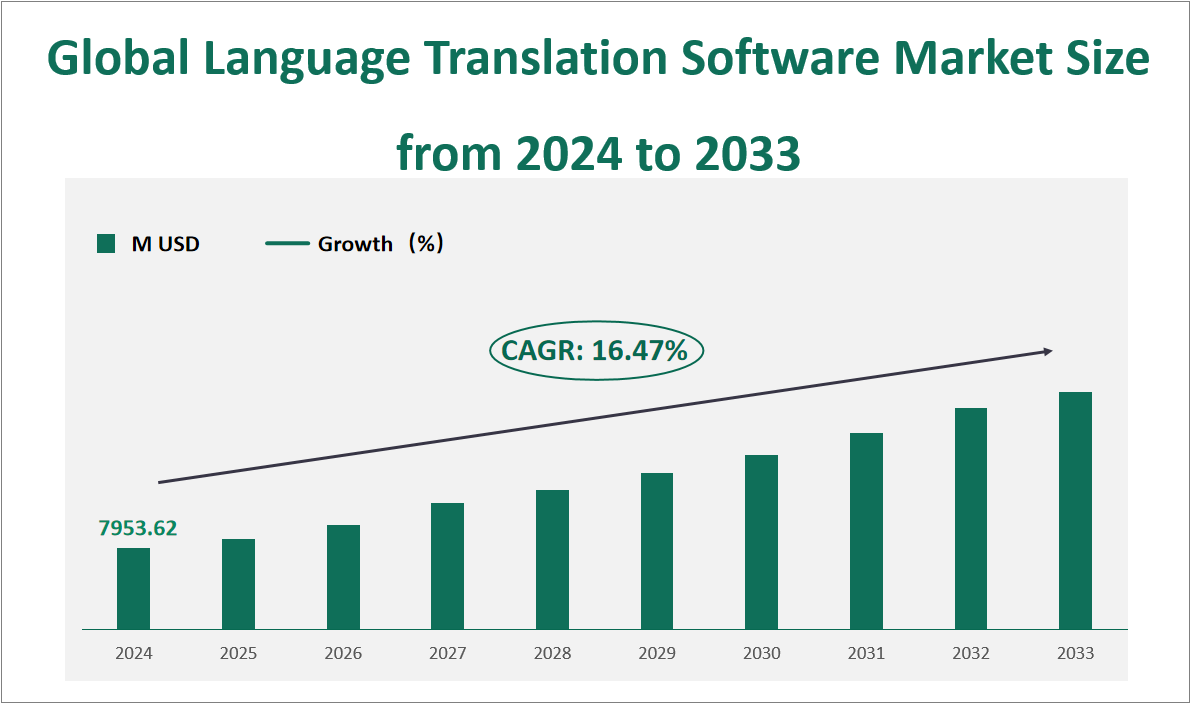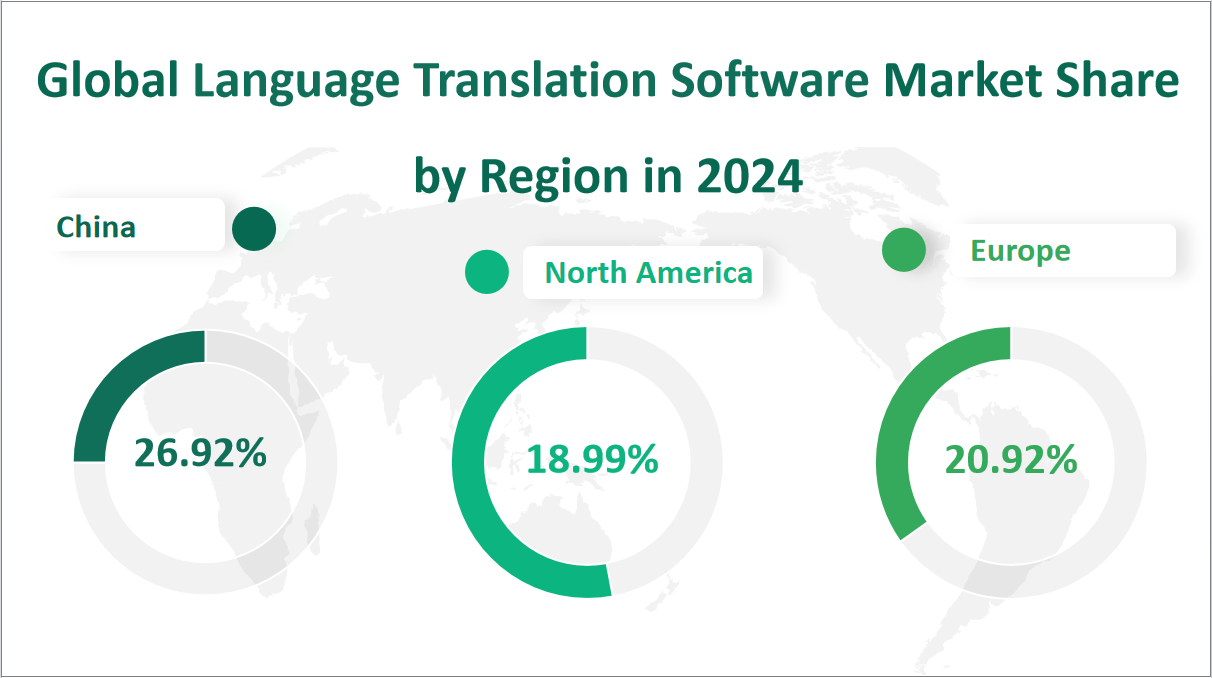1 Global Language Translation Software Market Outlook
The global Language Translation Software market is projected to exhibit substantial growth in the coming years, with a CAGR of 16.47% from 2024 to 2033, reaching a total market size of $7953.62 million USD in 2024. Language Translation Software is a critical tool in the modern globalized world, enabling businesses and individuals to communicate across linguistic barriers. This software utilizes advanced algorithms and machine learning techniques to translate text from one language to another, providing real-time translations and enhancing cross-cultural communication. The technology has become increasingly sophisticated, with the integration of artificial intelligence (AI) and cloud-based platforms, which have significantly improved translation accuracy and efficiency.
Figure Global Language Translation Software Market Size and Growth Rate (2024-2033)

2 Language Translation Software Market Growth Drivers and Constraints
The growth of the Language Translation Software market is driven by several key factors. One of the primary drivers is the increasing globalization of businesses, which necessitates effective communication across different languages. The rise of e-commerce and the need for localized content have also fueled the demand for translation software. Additionally, advancements in artificial intelligence and machine learning have significantly improved the accuracy and efficiency of translation services, making them more accessible and reliable.
Another significant driver is the growing demand for non-English languages in emerging markets such as South America and the Asia-Pacific region. As these regions continue to develop economically, the need for translation software to facilitate international trade and communication has increased. Furthermore, the increasing use of smartphones and other mobile devices has made translation software more accessible to a broader audience.
However, the market also faces several limiting factors. One of the main challenges is the availability of free translation services, which can deter businesses from investing in more advanced and costly solutions. Additionally, the complexity of certain languages and dialects can pose challenges for translation software, potentially limiting its effectiveness. The high costs associated with developing and maintaining advanced translation algorithms can also be a barrier for smaller companies.
Another limiting factor is the lack of understanding of the functions and benefits of translation software among potential users. Many businesses and individuals may not fully appreciate the value of investing in high-quality translation software, opting instead for free or lower-quality alternatives. This can hinder the market’s growth potential.
3 Language Translation Software Market Innovations and M&A Activities
The Language Translation Software market has witnessed significant technological innovations in recent years, driven by advancements in artificial intelligence and machine learning. These technologies have enabled translation software to become more accurate and efficient, providing real-time translations and improving overall user experience. The integration of AI has also allowed for more nuanced translations, capturing the subtleties of language that were previously difficult to achieve.
Corporate mergers and acquisitions have also played a crucial role in shaping the market. Major players such as Google and IBM have been actively investing in and acquiring smaller companies to enhance their translation capabilities. For instance, Google’s acquisition of various AI-focused startups has significantly bolstered its translation services. Similarly, IBM’s acquisition of Red Hat has expanded its capabilities in hybrid cloud solutions, which can be leveraged to improve translation software.
Other notable developments include the rise of cloud-based translation platforms, which offer scalability and flexibility. These platforms have become increasingly popular among businesses, particularly those with a global presence. The use of machine translation and manual post-editing has also gained traction, providing a balance between automation and human expertise.
In conclusion, the Language Translation Software market is poised for significant growth, driven by technological advancements and increasing global demand. While challenges such as competition from free services and the complexity of certain languages persist, the market’s potential for innovation and expansion remains strong. As businesses continue to globalize and the need for effective communication across linguistic barriers grows, the importance of high-quality translation software will only increase.
4 Global Language Translation Software Market Analysis by Type
In 2024, the global Language Translation Software market is forecasted to reach a total value of 7,953.62 million USD. The market is segmented into two primary types: On-premises and Cloud-based solutions. The On-premises segment is expected to be valued at 1,651.97 million USD, accounting for approximately 20.77% of the total market value. Meanwhile, the Cloud-based segment is projected to dominate the market with a value of 6,301.66 million USD, representing 79.23% of the total market value. This distribution highlights the growing preference for cloud-based solutions due to their scalability and flexibility, which are increasingly important as businesses expand their global operations and require more efficient translation services.
Table Global Language Translation Software Market Size and Share by Type in 2024
Type | Market Size in 2024 (M USD) | Market Share in 2024 (%) |
|---|---|---|
On-premises | 1651.97 | 20.77% |
Cloud | 6301.66 | 79.23% |
5 Global Language Translation Software Market Analysis by Application
In 2024, the global Language Translation Software market is forecasted to reach a total value of 7,953.62 million USD, with various applications contributing to this growth. The market is segmented by application as follows:
Banking, Financial Services, and Insurance: Expected to be valued at 1,509.60 million USD, accounting for approximately 18.98% of the total market value.
Healthcare: Projected to be valued at 560.73 million USD, representing 7.05% of the total market value.
Manufacturing: Anticipated to be valued at 530.51 million USD, holding a market share of 6.67%.
Government: Expected to be valued at 810.47 million USD, contributing 10.19% to the total market.
IT & Telecom: Projected to be valued at 2,494.26 million USD, representing 31.36% of the total market value.
Education: Anticipated to be valued at 1,333.03 million USD, holding a market share of 16.76%.
Others: Expected to be valued at 715.03 million USD, accounting for 8.99% of the total market value.
These forecasts highlight the significant role of IT & Telecom and Education in driving the Language Translation Software market, while also indicating substantial contributions from Banking, Financial Services, and Insurance, as well as Government applications.
Table Global Language Translation Software Market Size and Share by Application in 2024
Application | Market Size in 2024 (M USD) | Market Share in 2024 (%) |
|---|---|---|
Banking Financial Services and Insurance | 1509.60 | 18.98% |
Healthcare | 560.73 | 7.05% |
Manufacturing | 530.51 | 6.67% |
Government | 810.47 | 10.19% |
IT & Telecom | 2494.26 | 31.36% |
Education | 1333.03 | 16.76% |
Others | 715.03 | 8.99% |
6 Global Language Translation Software Market Analysis by Region
In 2024, the global Language Translation Software market is projected to reach a total value of 7,953.62 million USD, with significant contributions from various regions. North America is expected to hold a market value of 705.52 million USD, accounting for approximately 18.99% of the global market share. Europe is anticipated to contribute 777.22 million USD, representing 20.92% of the total market. China is projected to lead with a value of 1,000.14 million USD, capturing 26.92% of the market share. Japan is expected to contribute 280.87 million USD, holding 7.56% of the market. The Middle East & Africa region is forecasted to reach 180.75 million USD, representing 4.87% of the global market. India is anticipated to contribute 138.91 million USD, accounting for 3.74% of the market. South America is expected to have a market value of 374.49 million USD, holding 10.08% of the global market share. These forecasts highlight the diverse contributions from each region, with North America and Europe maintaining significant shares, while China’s rapid growth underscores its pivotal role in the global Language Translation Software market.
Figure Global Language Translation Software Market Share by Region in 2024

7 Top 3 Companies of Global Language Translation Software Market
7.1 Google Inc
Company Introduction and Business Overview:
Google Inc, founded in 1998, is an American multinational technology company specializing in Internet-related services and products. Headquartered in Mountain View, California, Google is one of the Big Four technology companies, alongside Amazon, Apple, and Facebook. The company’s core business includes online advertising technologies, search engine services, cloud computing, software, and hardware. Google’s mission is to organize the world’s information and make it universally accessible and useful.
Products Offered:
Google offers a comprehensive suite of language translation services, including its widely-used Google Translate. This service enables real-time translation between multiple languages using advanced machine learning models. Google Translate supports a wide range of languages and can be accessed through its website, mobile applications, and integrated into various Google services. Additionally, Google provides APIs for developers to integrate translation capabilities into their own applications, making it a versatile solution for businesses and developers alike.
Sales Revenue in the Latest Year:
Google’s revenue in the Language Translation Software market was 432.92 million USD, with a gross margin of 39.71%. The company’s market share stood at 11.66%, reflecting its dominant position in the industry. Google’s continuous investment in research and development, particularly in artificial intelligence and machine learning, has enabled it to maintain a competitive edge and drive its revenue growth and market share expansion.
7.2 IBM Corporation
Company Introduction and Business Overview:
IBM Corporation, founded in 1911, is an American multinational information technology company headquartered in Armonk, New York. IBM is a leading provider of cloud platform and cognitive solutions, offering a wide range of services including software, hardware, and consulting. The company’s focus on innovation and technology has enabled it to maintain a strong presence in the global market.
Products Offered:
IBM offers a variety of language translation services, including its Watson Language Translator. This service leverages IBM’s advanced AI capabilities to provide real-time translation and localization services. IBM’s translation solutions are designed to support businesses in their global expansion efforts, enabling seamless communication across different languages and cultures. Additionally, IBM provides APIs and SDKs for developers to integrate translation capabilities into their applications, making it a comprehensive solution for enterprises.
Sales Revenue in the Latest Year:
IBM’s revenue in the Language Translation Software market was 357.51 million USD, with a gross margin of 37.57%. The company’s market share was 9.62%, positioning it as one of the top players in the industry. IBM’s commitment to innovation and its extensive portfolio of services have enabled it to maintain a strong market presence and drive its revenue growth.
7.3 NetEase, Inc (Youdao)
Company Introduction and Business Overview:
NetEase, Inc, founded in 1997, is a Chinese Internet technology company headquartered in Hangzhou, China. The company provides a wide range of online services, including content, community, communications, and commerce. NetEase is known for its diverse product offerings, including online games, advertising services, email services, and e-commerce platforms. Youdao, a subsidiary of NetEase, focuses on educational technology and language translation services.
Products Offered:
Youdao offers a comprehensive suite of language translation services, including its popular Youdao Dictionary. This service provides multilingual translation capabilities and is widely used by students, professionals, and businesses. Youdao’s translation solutions are designed to support various applications, from educational tools to business communication. Additionally, Youdao offers APIs and SDKs for developers to integrate translation capabilities into their applications, making it a versatile solution for different user needs.
Sales Revenue in the Latest Year:
Youdao’s revenue in the Language Translation Software market was 312.47 million USD, with a gross margin of 38.58%. The company’s market share was 8.41%, reflecting its strong position in the industry. Youdao’s continuous investment in research and development, particularly in educational technology and language translation, has enabled it to maintain a competitive edge and drive its revenue growth and market share expansion.

